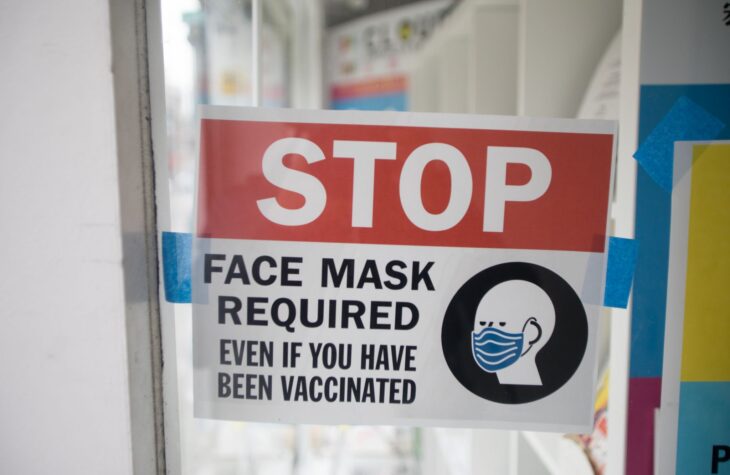
Policy Brief: COVID Mask Mandates Prove Both Ineffective and Unsupported by the Evidence

Synopsis
Amid the latest surge of COVID-19 cases, elected officials and policymakers are once again imposing new restrictions and mandatory mask mandates. Many of these policies do not aim to mitigate the virus, but to reclaim social control over vast swaths of the American people. The data is clear that current and previous masking measures do little to mitigate the short-term transmission of the virus, do nothing to mitigate the long-term transmission of the virus, but in all cases result in educational and social harm, as well as present an extreme inconvenience to many who want to live their lives as close to normal as possible.
Background: Masks and the Spread of COVID-19
In March 2020, as COVID-19 began its spread across the United States, initial commentary from National Institute of Allergy and Infectious Diseases (NIAID) Director Anthony Fauci suggested Americans did not need to wear masks. Fauci went so far as to state, “When you’re in the middle of an outbreak, wearing a mask might make people feel a little bit better […] but it’s not providing the perfect protection that people think that it is.” Less than three months later, Fauci completely reversed this position and said that the benefits of masks essentially compel people to wear them.
During the initial outbreak, guidance from former Surgeon General Jerome Adams suggested that, “you can increase your risk of getting [COVID-19] by wearing a mask if you are not a health care provider.” Adams even went so far as to tell people to stop buying masks and tweeted that they were “NOT effective” at preventing public transmission of COVID-19. Adams has recently claimed that these statements were misleading and harmful. Former Centers for Disease Control and Prevention (CDC) Director Robert Redfield said last July, “If we all wore face coverings for the next four, six, eight, 12 weeks across the nation, this virus transmission would stop.” Public health officials have sent contradictory messages to the American people from the beginning.
The initial recommendations from public health and political leaders suggested that masks were an unnecessary and ineffective means of reducing the transmission of COVID-19. As outlined above, public officials have repeatedly contradicted these recommendations since then. And the contradictions have not ceased, as Dr. Fauci in just the last two months stated that the CDC would not alter its guidance about mask-wearing among vaccinated Americans. It turns out this claim only held up for a few weeks because CDC guidance as of August 2021 now recommends vaccinated Americans wear a mask indoors.
On August 2, 2021, Michael Osterholm of the University of Minnesota went on CNN and stated that many of the masks Americans are wearing are simply not very effective, a finding backed up by a recent study out of the University of Waterloo in Canada. Osterholm elaborated that N95 masks offer a higher degree of protection than cloth and surgical masks. However, official CDC guidance instructs Americans not to buy N95 masks so that healthcare workers can maintain access to this kind of equipment. The CDC says this despite former director Redfield saying in 2020 that cloth masks “are one of the most powerful weapons we have to slow and stop the spread of the virus.”
While there was considerable concern early on in the pandemic about the virus being transmitted by droplets and coarse aerosols—thereby supporting the argument for surgical masks—a study released in August 2021 from Oxford University found that 85 percent of COVID-19’s viral load is transmitted via fine aerosols, which would likely undercut the efficacy of masks. This revelation explains why mask measures up to this point have seemingly provided only marginal protection for virus mitigation.
Indeed, even the FDA points out that surgical masks are “meant to help block large-particle droplets, splashes, sprays, or splatter that may contain germs (viruses and bacteria).” The FDA’s own guidance states, “While a surgical mask may be effective in blocking splashes and large-particle droplets, a face mask, by design, does not filter or block very small particles in the air that may be transmitted by coughs, sneezes, or certain medical procedures.”
COVID Case Rates at a Glance
A look at case rates in states that imposed mask mandates and states that did not provide a sense of mask efficacy played out in real-time. Rhode Island was one of the earliest states to impose mask mandates and lockdowns. Since the start of the pandemic, it has had the second highest COVID case rate in the nation at 15,826 per 100,000. New Jersey, which recently reimposed new mask mandates and also implemented some of the earliest and strictest mandates and lockdowns, has the second highest case fatality rate in the country at 306 deaths per 100,000.
Meanwhile, a state like Florida, which did not issue a statewide mask mandate, has a case fatality rate of 237 per 100,000. This puts Florida at number 10 in terms of number of deaths, below the mask mandate and lockdown-prone states like New Jersey, New York, and Rhode Island.
Governor Ron DeSantis (R-FL) left masking policies up to local officials. Despite having a higher population than New York, which imposed a mask mandate in April 2020, Florida’s case fatality rate is currently 16 percent lower than the Empire State’s (237 vs 281).
At a minimum, this data suggests that masks, or at least mask mandates, are not the panacea that advocates have claimed.
Empirical Research Regarding Masks and Transmission of Respiratory Viruses
Over the past several decades, there have been a number of studies conducted around the world to determine the efficacy of masks with regard to reducing transmission of various respiratory viruses. Some of these studies provide important data points worth highlighting as the call for mandatory mask wearing once again resurfaces, especially with regard to school-aged children.
One of the strongest scientific studies for evaluating information is known as a Randomized Controlled Trial (RCT). These are performed to draw conclusions necessary for public policy and public health guidance. Each of these RCTs typically breaks down groups of people into two separate categories: the control group and what researchers typically call the intervention group. And while this paper will not touch upon every study performed with regard to mask-wearing and respiratory viruses, it will highlight key findings and data points of significance.
After all, the American people have consistently been told by experts, politicians, and the media that mask-wearing guidance is predicated on the underlying science.
So what is the underlying science?
A relatively recent study performed in 2016 in Beijing serves as one of the few RCTs demonstrating a potential benefit of mask-wearing. The results of this study revealed that the rates of clinical respiratory illness and laboratory-confirmed viral infections were consistently lower in the mask-wearing group. However, the data in this study was not of statistical significance in part because of the overall low influenza-like illness (ILI) infection rate in both groups. Therefore, the benefits were so marginal that no definitive conclusion could be reached.
Indeed, the authors of the Beijing study stated in their conclusion that there is a potential benefit of medical masks, but that larger trials are needed to confirm the efficacy of masks as a source of viral transmission control. In their own assessment, medical masks remain commonly used by sick individuals with influenza-like illness (ILI) to prevent spread of infections to others, but clinical efficacy data are sparse.
A 2011 study conducted on Australian Muslim pilgrims visiting Saudi Arabia found masks to be a statistically significant tool for reducing respiratory viral transmission. Only 31 percent of those who wore a mask developed respiratory symptoms compared to 53 percent who did not wear a mask. But there are major problems with this particular study, namely that it only included 164 people (a very small sample size) and accepted self-reporting to determine whether someone had developed a respiratory illness.
A study conducted in 2020 out of Denmark aimed specifically at determining the effectiveness of masks against COVID-19 provided results that were less than conclusive for mask mandate proponents. The study included nearly 5,000 participants, a large enough number of people to draw some conclusions. The Danish study divided participants into a mask-wearing group and a non-mask control group. The study found that 1.8 percent of those in the mask group became infected with COVID-19, while 2.1 percent in the non-mask group became infected.
The large sample size for this study fits the suggested recommendations outlined by the authors of the Beijing study. And yet the findings in this large RCT show only a 0.3 percentage point difference. The benefits of wearing a mask, therefore, according to this large and COVID-focused RCT, would appear marginal at best.
Other studies are far less favorable to proponents of masks.
A 2010 study out of France randomly assigned sick individuals and members of their households into a group that wore masks and a group that did not. The no-mask group was considered the control group. That study found that 16.2 percent of those in the masked group developed an influenza-like illness (ILI) while 15.8 percent in the no-mask group developed the same illness. Statistically, this study suggests there is no advantage to wearing a mask. The authors of this study stated that “we did not identify any trend in the results suggesting effectiveness of facemasks.”
Similarly, an RCT published in New York in 2010 separated individuals into a hand-hygiene-only group and a mask plus hand-hygiene group. The results of this study were interesting in that roughly 42 percent of those in the hand hygiene-only group experienced symptoms of an upper respiratory infection while nearly 61 percent in the mask plus hand hygiene group experienced an upper respiratory infection. While we cannot know for sure whether there were other factors at play, these findings are of statistical significance and, in this trial, suggest that wearing a mask was not only less effective, but potentially counterproductive for preventing primary infection.
A 2007 study out of Hong Kong divided households into three different groups to assess whether non-pharmaceutical interventions could reduce the spread of flu-like viruses. Specifically, the Hong Kong study was aimed at determining the feasibility and efficacy of facemasks and hand hygiene. One of the key findings in this study was that the secondary attack rate of the ILI was twice as high in the mask group as in the hand hygiene and control groups. While the overall difference was not statistically significant (8 percent secondary attack rate for masks compared to 4 percent for the other two groups), the findings nevertheless undermine arguments in favor of masks as a means to reduce transmission.
Simply put, their effectiveness appears to be marginal at best. The only conclusion one can reach is that mask policies for the general public do not correlate with an actual reduction in viral transmission.
The Bangladesh Study
On September 1, 2021, the findings of a large-scale RCT conducted in Bangladesh were released regarding the efficacy of mask-wearing. The study included over 340,000 individuals in nearly 600 villages with groups separated into a control element and an intervention group. The concluding assessment, which has been highly touted by proponents of mask mandates, is that mask-wearing as an intervention “demonstrates a scalable and effective method” to reduce symptomatic COVID-19 infection, with a nearly 12 percent reduction in symptomatic COVID-19 and a 9.3 percent reduction in seroprevalence.
However, there are key questions that remain about this study.
The study did not conduct a large-scale baseline test for seroprevalence of COVID-19 antibodies prior to moving individuals into the control and intervention groups, meaning it is unclear how many participants had already had prior COVID-19 infections. This would have given researchers a more accurate comparison of seroprevalence in both groups before and after the masking intervention.
Importantly, the researchers also only tested those who self-reported symptoms, which would potentially bias results of the study. With individuals receiving COVID-19 testing after reporting symptoms, this raises the possibility of whether a demand effect was transpiring over the course of this study. A demand effect is when participants in a study interpret the purpose of the study and change their behavior in accordance with what they believe is occurring.
Such an effect would bias results of the Bangladesh study and likely skew the findings.
Those who released the study should address some of these shortcomings and provide more information going forward.
Flashpoint: Mask Mandates in Schools
Perhaps the most controversial element of mask mandates is when they extend to school children. As the 2021-2022 school year is now beginning, parents are facing a second year of either virtual learning or their children being forced to cover their faces for hours on end.
As highlighted above, what data exists from various randomized controlled trials suggests a statistically insignificant benefit to wearing a mask. A large-scale study of COVID-19 transmission in schools, published by the CDC, found this also applied to student masking measures.
These findings were further bolstered by a study conducted in Spain and published in July 2021 that showed COVID-19 transmission rates were higher among school children ages six and up, who are required to wear masks, compared to younger children who are not required to mask.
Furthermore, data taken straight from the CDC reveals that children, thankfully, are far less susceptible to illness from COVID-19. As of the publishing of this paper, 439 children between the ages of 0 and 17 have died from COVID-19 in the past 18 months. The total number of cases thus far in this demographic stands at 4,528,664. This translates into a case fatality rate of 0.01 percent. The real fatality rate is likely significantly lower than even that small number based on the number of asymptomatic cases that were never diagnosed.
Obviously, every one of these deaths is an immense tragedy for these families. Nevertheless, decisions for the populace on the whole must be made using the available evidence showing that the flu is actually more dangerous for children than COVID-19.
During the last flu season, from October 2018 to February 2019, 477 children passed away. This is a 9 percent higher mortality count in just a fraction of the time.
Empirical evidence from other fields of study suggests that children need facial communication and expression for their own social-emotional development as well as educational advancement. A 2017 study showed that kids with a strong ability to read facial expressions performed better academically. On the flipside, a 2009 study revealed that kids who struggle to read facial expressions are more likely to struggle in school and in social settings. The imposition of a mask is an obvious barrier for this critical developmental indicator in children.
Additionally, there is no data or scientifically significant study that provides information related to the development of a child’s immune system in connection with constant mask-wearing. In other words, there is currently no way to balance any public policy tradeoff with whether wearing a mask all day harms the development of a robust immune system in kids.
Important educational indicators must also be examined. Opponents of mandatory masking in schools have appropriately pointed out the difficulty that some kids have with learning when it comes to their teachers wearing a mask. There remain questions about whether the covering of a teacher’s face inhibits the ability of kids to learn how to enunciate, spell, and speak their own language properly.
To date, no longitudinal, large-scale study has been performed to answer this question.
On the whole, remote learning and onerous restrictions imposed for in-person learning have resulted in significant educational declines across the country.
- In Baltimore, 68 percent of 9th graders failed a class during the 2020-2021 school year. Some 55 percent of Baltimore students in second grade through fifth grade failed at least one class, a 25 percent increase from the previous year.
- Fifth graders in Tennessee saw a double-digit decline in math performance from 2019 to 2021. In 2019, 46 percent of fifth-grade students were performing at grade level compared to just 31 percent in 2021.
- In Colorado, just 29.5 percent of eighth-graders were competent at grade level in math, a decline of 7.4 percent from the previous year.
- Roughly 40 percent of middle school and high school students in Los Angeles were disengaged or not present in classes during the initial school closures of the pandemic.
- A recent report by consulting firm McKinsey & Company found that, on average, students in first through sixth grade were five months behind in math and four months behind in reading proficiency by the end of the 2020-2021 school year.
While obviously there are myriad factors behind ongoing failures in public education, including the impact of radical curricula stemming from Critical Race Theory, there can be little doubt that remote learning and onerous mandates are harming student outcomes.
The McKinsey report found that the average K-12 student could lose up to $82,000 of lifetime earnings because of modified learning measures mandated in response to COVID-19. Children must go to school and they must be put in a learning environment that allows them to develop into capable adults willing and able to participate responsibly in civil society.
Many parents have responded to the poor performance and onerous restrictions in public schools by pulling their children out of the public school system altogether. Over 10,000 local public schools lost over 20 percent enrollment of their kindergarten students.
In Fairfax County, Virginia, the public school system has lost nearly 10,000 students since the pandemic began. In New York, enrollment in public schools has declined 2.6 percent across the state, the largest decline in 40 years.
Unsurprisingly, this has translated into increased support for school choice. Polling from last fall showed that support for school choice increased 10 percent among public school parents, leaping from 67 percent to 77 percent support.
And in the latest data from the U.S. Census Bureau, 11.1 percent of families now report homeschooling their children. This is nearly double the percentage of homeschooling households documented the previous school year.
The bottom line is that all available data we have shows that COVID-19 is less dangerous to children than the flu. Children have suffered emotional, educational, social, and developmental setbacks due to unscientific policies implemented by arrogant bureaucrats and political elites. Parents are keenly aware of these realities.
Therefore, it is incumbent on policymakers and elected officials to follow the science and ensure that children are not subjected to burdensome restrictions and school closures that will cause long-term harm.
Concluding Assessment
As the fourth wave of COVID-19 rolls across the United States, policymakers and elected officials intending to reimpose onerous policies such as mask mandates lack both the trust of the public and the empirical data to justify these measures. With the widespread availability of medications, inoculations, and supplements available over the counter, vulnerable Americans and those concerned about COVID-19 have easily accessible choices for providing themselves additional protection.
The American people are ready to live their lives again and to see their society both functioning and flourishing. Efforts to seize power through unscientific mandates and authoritarian policies must be resisted. There is simply no justification for implementing or adhering to such measures.



